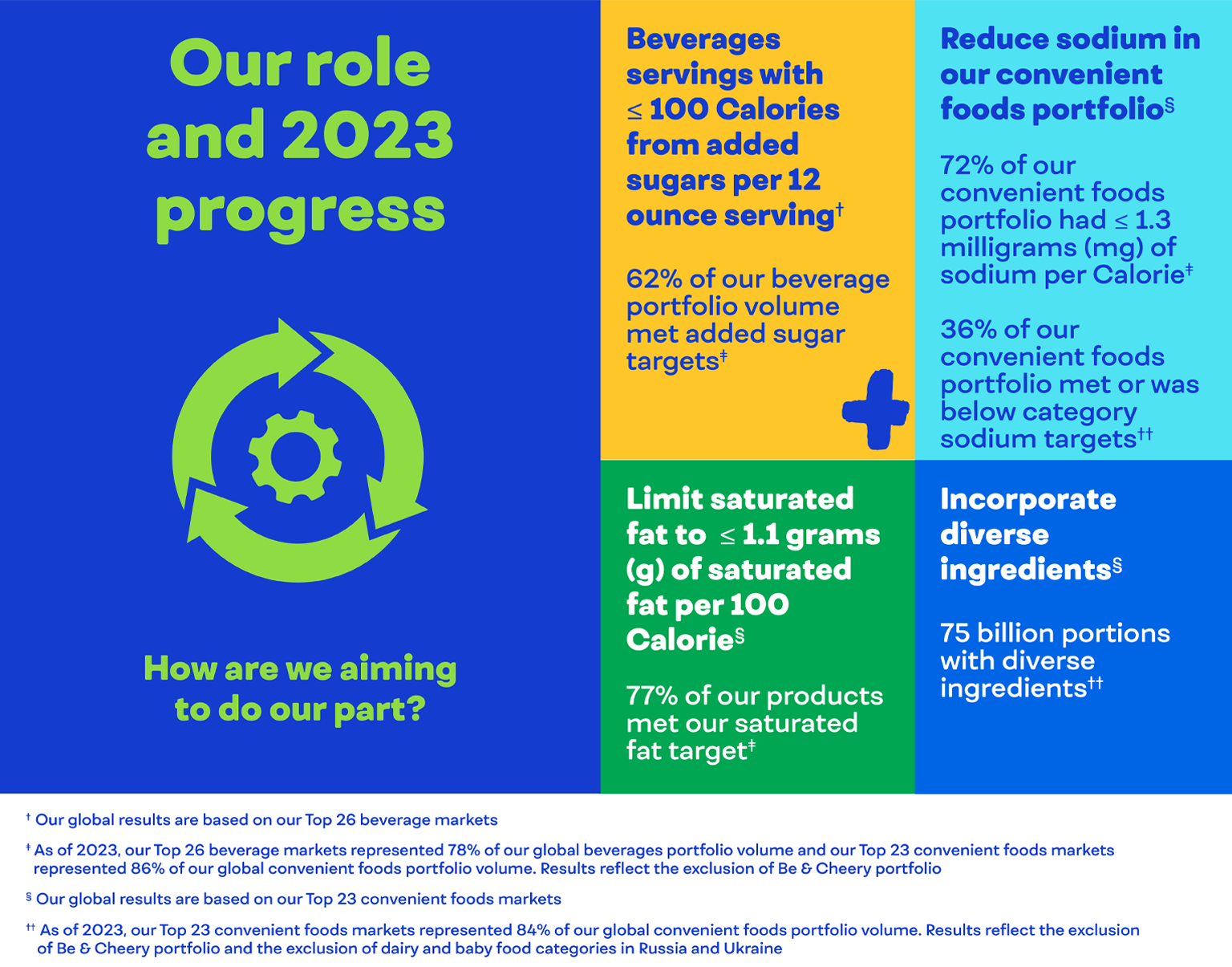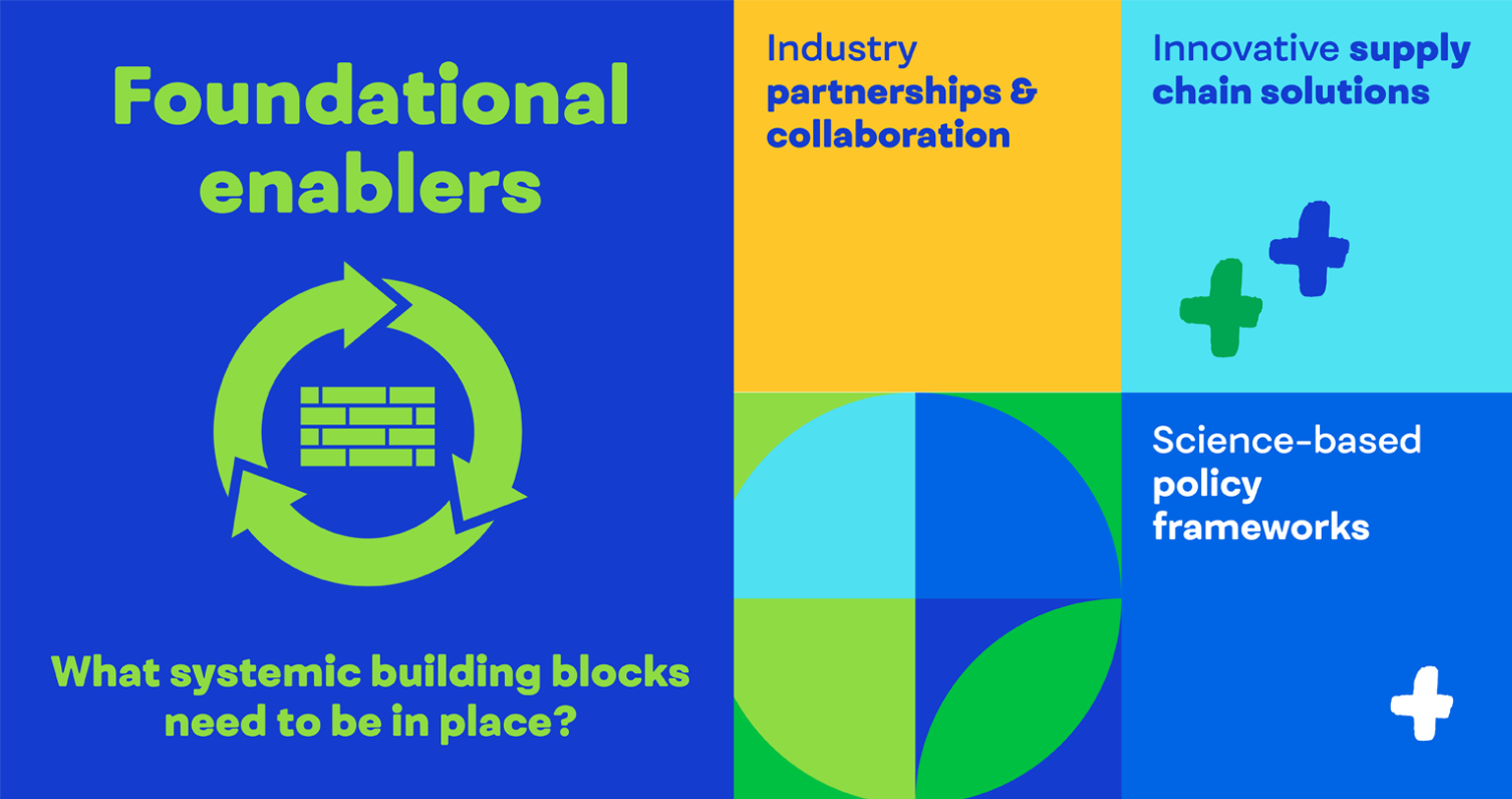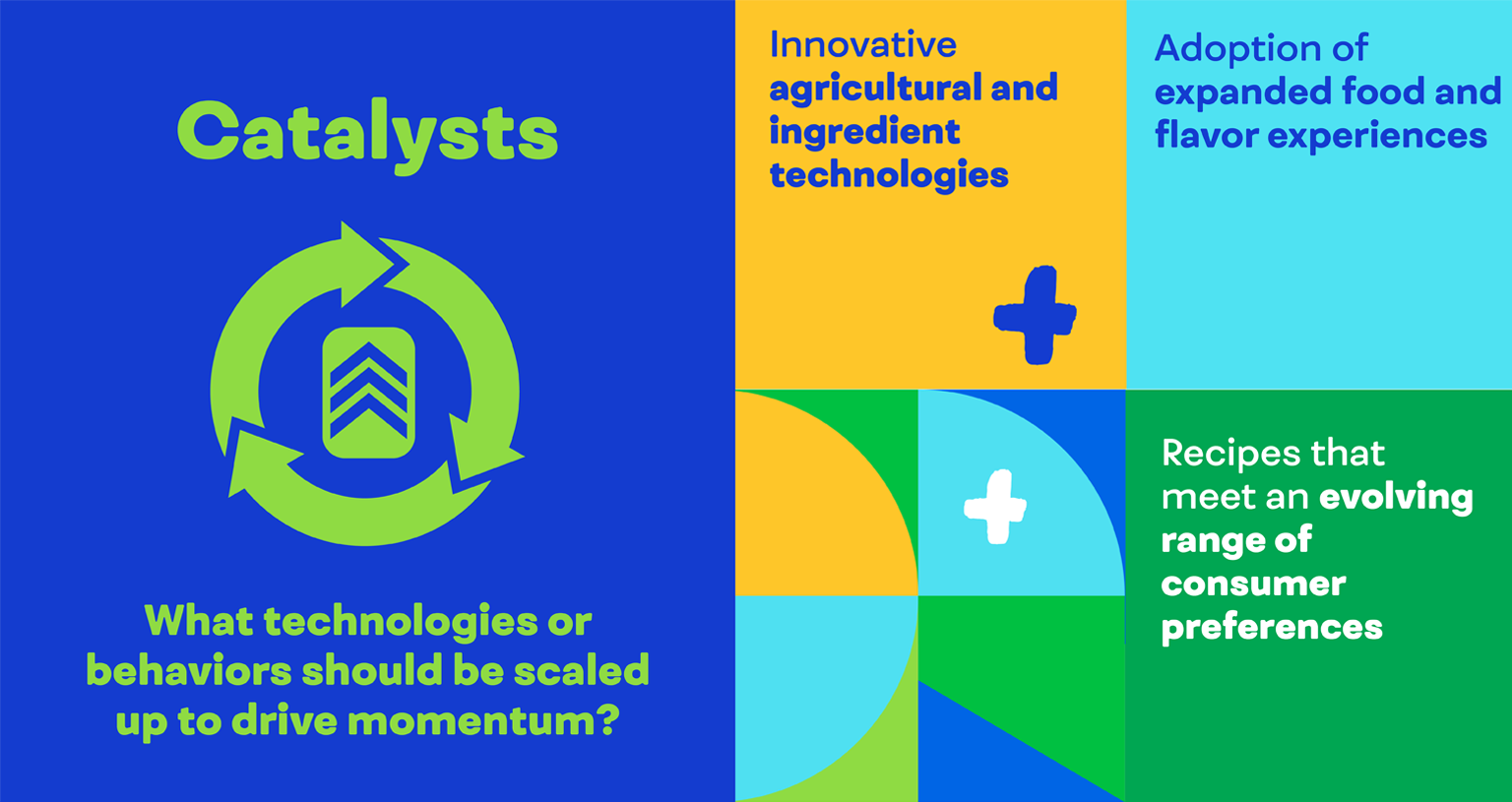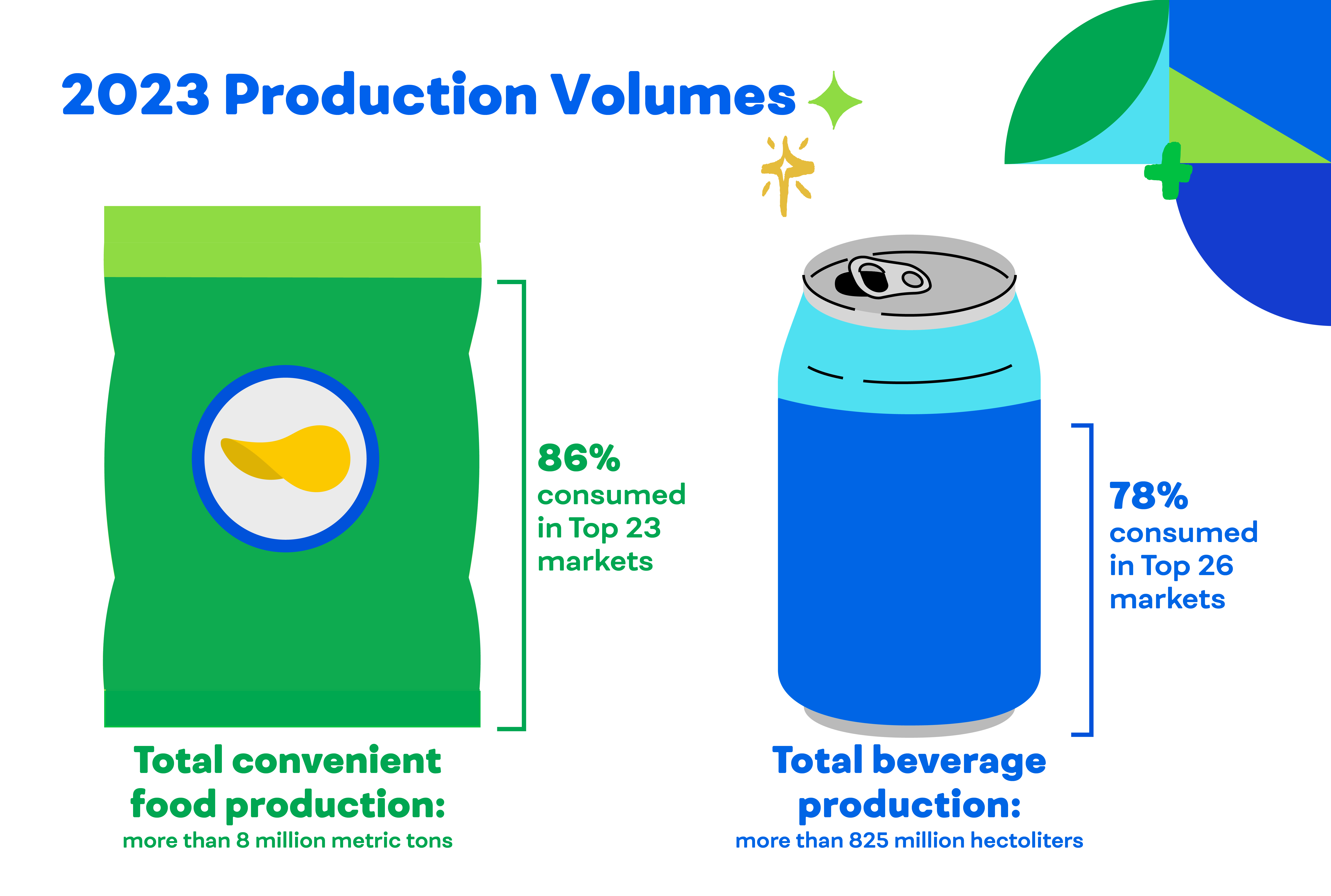ESG Topics A-Z
Nutrition

To PepsiCo:
Consumers enjoy PepsiCo products more than one billion times a day, all around the world. With that scale comes an opportunity to provide people and families with foods and beverages that are nutritious, enjoyable and fit their lifestyle. We're working to help make the Positive Choice the easy choice.
To the World:
Eating an excess of added sugars, sodium or saturated fats are leading risk factors across the globe for diet-related conditions. At the same time, many people around the world are not eating enough nutritious food groups and ingredients. Although many of our products are not intended to be core elements of the daily diet, we strive to act as an industry leader and aim to set ambitious nutrition goals that will support positive choices, now and for many years to come.
Approach
Over the past decade, we have changed many of our recipes to reduce added sugars, sodium and saturated fat. But we're not stopping now. When we launched our pep+ (PepsiCo Positive) ambitions in 2021, we set three global nutrition targets to be met by 2025:
- ≥ 67% of beverage portfolio volume will not exceed 100 Calories from added sugars per 12 ounce serving.1
- ≥ 75% of convenient foods portfolio volume will not exceed 1.3 milligrams (mg) of sodium per Calorie.2
- ≥ 75% of convenient foods portfolio volume will not exceed 1.1 grams (g) of saturated fat per 100 Calories.2
We met our saturated fat goal four years ahead of schedule and have made significant progress on our 2025 added sugars and sodium goals. To take the next step on our nutrition evolution and help to catalyze change in the industry, we set two new goals to be achieved by 2030. These ambitions factor in ongoing public health concerns of excess sodium intake and low consumption of food groups and ingredients that are important sources of nutrition.
By 2030, our goals are:
- To ensure at least 75% of our global convenient foods portfolio volume will meet or be below category sodium targets.3 These targets have been set across approximately 30 product categories ranging from hot cereals to potato chips and are approximately 15-30% lower than our current target of 1.3 mg per Calorie. For example, our new sodium goal aims for a 15% sodium reduction in our U.S. Lay's Classic Potato Chips, which would result in a sodium level of 140 mg per 28 g serving; and
- To deliver 145 billion portions of diverse ingredients annually in our global convenient foods portfolio.2 We define diverse ingredients as food groups or ingredients – such as legumes, whole grains, plant-based proteins, fruits and vegetables and nuts and seeds – that people do not consume enough of in many countries. Our goal is to ensure each portion will provide approximately 10% of the suggested daily amount of a diverse ingredient.4
In addition to our pep+ ambitions, our Sectors have worked with select local governments to establish additional objectives based on local dietary recommendations.
For example, in Europe, where many countries have adopted the Nutri-Score nutrient profiling model, we have set an ambition to grow our ‘healthier snacking’ business, specifically:
- Building a $500 million “healthier snacking” business in the EU by 2025, with products that would be compliant with a Nutri-Score B definition or better (as defined in July 2021). Our ambition is to grow that part of our business to $1 billion by 2030.
- Transforming a range of our snacks that currently rate D or E in Nutri-Score to be compliant with a C classification or better (as defined in July 2021). Our ambition is to grow that part of our business to $400 million by 2025, and to $500 million by 2030.
Progress against these European objectives are reported to the European Commission in an annual progress report.
In India, we are a signatory to the Food Safety & Standards Authority of India’s Eat Right Pledge, striving to increase positive nutrition like whole grains, fruits and vegetables, dairy, protein and hydration by expanding our portfolio containing one or more of these ingredients.
Globally, we partner with communities in an effort to advance food security and to make nutritious food accessible. For more information, see Food and nutrition security.
Product innovation
We'll aim to meet our nutrition ambitions through a combination of current offerings, reformulating our existing products and innovating to come up with new ones. The important tasks of reformulating and innovating fall largely to our more than 2,600 Research and Development (R&D) employees across 18 R&D centers around the world. Our R&D team is focused on:
- Innovating on the farm: Agricultural experts partner with farmers to grow potatoes that have the ideal flavor or oats with more fiber and protein.
- Maintaining taste: Flavor and seasoning experts identify savory and sweet ingredients and study salt crystal shapes and sizes to optimize flavor while using less sugar or sodium.
- Creating texture: Recipe experts use popping and baking methods that add a range of textures and use less oil.
PepsiCo Nutrition Criteria
Our nutrition sciences team developed the PepsiCo Nutrition Criteria (PNC) to provide nutritional guidance to the teams creating our foods and beverages, whether they are reformulating existing products or developing new ones. These science-based criteria consider recommendations for food and nutrient intake from leading global and national public health authorities including the World Health Organization (WHO), the U.S. Department of Agriculture (USDA) and the National Academy of Medicine.
The PNC standards include guidance on:
- Nutrients to limit: Nutrients that, when consumed in excess, have been well-established as dietary factors that can contribute to the risk of certain diet-related conditions. They include: Saturated fat, Trans fat, Sodium and added Sugars.
- Nutrients to encourage: Nutrients that have been identified as being commonly under-consumed in the population. They are sometimes called “shortfall nutrients.” They typically include: fiber, specific vitamins and/or minerals such as iron, vitamin D and calcium.
- Food groups to encourage: Food groups that have been established as contributing to well-balanced diets, including legumes, whole grains, plant-based proteins, fruits and vegetables and nuts and seeds.
pep+ in context: Nutrition



Progress
Our impact and product transformation

In 2023, consumers enjoyed more than eight million metric tons of PepsiCo convenient foods and more than 825 million hectoliters of our beverages.
Given our scale, through a combination of product reformulations, innovations and acquisitions, we continue to pursue our goal of delivering more positive choices by:
- Offering existing products:
- Our U.S. Lightly Salted product line contains 50% less sodium than their traditional counterparts.
- Lay’s Baked snacks are available in 35+ markets, bringing consumers great taste with less fat.
- In the U.S., U.K. and Canada, Bare Apple Chips - Crispy Reds are made from apples.
- Renovating existing recipes:
- Since 2016, 7UP, Mountain Dew and Mirinda have been reformulated to recipes with 30-50% less added sugars across 41 markets.
- In Pakistan, Lay’s Yogurt & Herb renovation meets our 2030 sodium target.
- We reduced saturated fat by cooking Doritos in Mexico and Lay’s in Saudi Arabia and China with alternative oils.
- Launching new products:
- We offer Pepsi Zero Sugar in 121 international markets and 7Up Zero Sugar in 70+.
- In Egypt, Doritos Flamin’ Hot Xxtra Tortilla Chips meet 2030 sodium targets.
- China’s Quaker Multigrain Five Red Oatmeal contains legumes, whole grains and fruit, and in the U.S., we recently launched Lay’s Veggie Poppables made with vegetables.
For more detail on our progress against our product goals, see Saturated fat, Sodium and Sugar.

Progress
As of 2023, we made significant progress toward our 2025 targets:
- On added sugars, 62% of our beverage portfolio volume met our 2025 goal;5
- On sodium, 72% of our convenient foods portfolio volume already meets our 2025 goal;5 and
- On saturated fat, we again surpassed our 2025 goal, with 77% of our convenient foods portfolio meeting our standards.5
Additionally, we made progress toward our 2030 nutrition ambitions:
Challenges
- The global public health challenges facing our population are significant and our efforts alone cannot solve them. But we aim to help make positive choices available to more people every day.
- Additionally, we recognize the persistent challenge posed by global hunger and are working to help advance food security and make nutritious food more accessible to people in need.
What's next?
PepsiCo understands the important role of nutrition in public health, and we remain focused on improving the nutritional quality of products within our portfolio to provide more positive choices for our consumers.
2 Our global results are based on our Top 23 convenient foods markets
3Our global results are based on our Top 23 convenient foods markets. Refer to the Sodium ESG Topics A-Z page for complete list of food categories
4Based on published dietary guidelines for select countries, WHO Healthy Diet Fact Sheet and Eat Lancet Planetary Healthy Diet report.
5As of 2023, our Top 26 beverage markets represented 78% of our global beverages portfolio volume and our Top 23 convenient foods markets represented 86% of our global convenient foods portfolio volume. Results reflect the exclusion of Be & Cheery portfolio
6As of 2023, our Top 23 convenient foods markets represented 84% of our global convenient foods portfolio volume. Results reflect the exclusion of Be & Cheery portfolio and the exclusion of dairy and baby food categories in Russia and Ukraine
7Including legumes, whole grains, plant-based proteins, fruits and vegetables and nuts and seeds
Related topics
Food and nutrition security, Product labeling and claims, Saturated fat, Sodium, Sugar, Trans fat
Downloads
Last updated
June 19, 2024